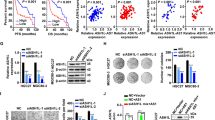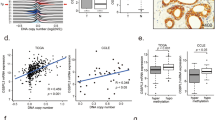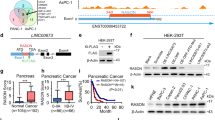Abstract
The Ras association domain family (RASSF) encodes several members with tumor-suppressive potentials. We aimed to investigate the biological function and clinical implication of RASSF10 in gastric cancer (GC). We found that RASSF10 was silenced in six of seven GC cell lines and in primary GC tissues, but was highly expressed in normal gastric tissues. The silence of RASSAF10 was mediated by promoter methylation as evaluated by bisulfite genomic sequencing. RASSF10 expression could be restored by demethylation treatment. A negative correlation between methylation and mRNA expression of RASSF10 was observed in 223 gastric samples of The Cancer Genome Atlas study (P<0.0001). Re-expression of RASSF10 in GC cell lines (AGS and MKN45) significantly suppressed cell viability, colony formation, migration and invasion, reduced cells in S phase, accumulated cells in G2 phase and induced cell apoptosis in vitro, and inhibited tumorigenicity in nude mice. These were confirmed by decreased expression of proliferation markers (proliferating cell nuclear antigen, p-CDC2 and p-CDC25) and increased apoptotic cascades (cleaved caspases-9, -8, -3 and cleaved poly (ADP-ribose) polymerase). Conversely, RASSF10 knockdown in normal gastric cell line yielded an opposing effect. Co-immunoprecipitation combined with mass spectrometry analyses were performed to reveal the downstream effectors of RASSF10. The result revealed that glutathione S-transferase Pi 1 (GSTP1) was a direct cooperator of RASSF10. The tumor-suppressive effect of RASSF10 was partially mediated by cooperating with GSTP1 to deregulate Jun N-terminal kinase (JNK)/c-Jun/AP-1 pathway. Importantly, RASSF10 methylation was detected in 56.6% (98/173) of primary GCs and is an independent risk factor for poor survival of GC patients (P=0.001). In conclusions, RASSF10 functions as a tumor suppressor by cooperating with GSTP1 to deregulate JNK/c-Jun/AP-1 pathway in GC. Promoter methylation of RASSF10 is associated with poor survival of GC patients.
This is a preview of subscription content, access via your institution
Access options
Subscribe to this journal
Receive 50 print issues and online access
$259.00 per year
only $5.18 per issue
Buy this article
- Purchase on Springer Link
- Instant access to full article PDF
Prices may be subject to local taxes which are calculated during checkout







Similar content being viewed by others
Abbreviations
- BGS:
-
bisulfite genomic sequencing
- GC:
-
gastric cancer
- GSTP1:
-
glutathione S-transferase Pi 1
- JNK:
-
Jun N-terminal kinase
- MS-RDA:
-
methylation-sensitive representational difference analysis
- RASSF10:
-
Ras association domain family member 10
- RT–PCR:
-
reverse transcription–PCR
- shRNA:
-
small hairpin RNA
- siRNA:
-
short interference RNA
- TUNEL:
-
terminal deoxynucleotidyl transferase-mediated dUTP-digoxigenin nick end labeling.
References
Lozano R, Naghavi M, Foreman K, Lim S, Shibuya K, Aboyans V et al. Global and regional mortality from 235 causes of death for 20 age groups in 1990 and 2010: a systematic analysis for the Global Burden of Disease Study 2010. Lancet 2012; 380: 2095–2128.
Ferlay J, Shin HR, Bray F, Forman D, Mathers C, Parkin DM . Estimates of worldwide burden of cancer in 2008: GLOBOCAN 2008. Int J Cancer 2010; 127: 2893–2917.
Kim GD, Ni J, Kelesoglu N, Roberts RJ, Pradhan S . Co-operation and communication between the human maintenance and de novo DNA (cytosine-5) methyltransferases. EMBO J 2002; 21: 4183–4195.
Wang S, Cheng Y, Du W, Lu L, Zhou L, Wang H et al. Zinc-finger protein 545 is a novel tumour suppressor that acts by inhibiting ribosomal RNA transcription in gastric cancer. Gut 2013; 62: 833–841.
Yu J, Liang QY, Wang J, Cheng Y, Wang S, Poon TC et al. Zinc-finger protein 331, a novel putative tumor suppressor, suppresses growth and invasiveness of gastric cancer. Oncogene 2013; 32: 307–317.
Tomita H, Takaishi S, Menheniott TR, Yang X, Shibata W, Jin G et al. Inhibition of gastric carcinogenesis by the hormone gastrin is mediated by suppression of TFF1 epigenetic silencing. Gastroenterology 2011; 140: 879–891.
Xu L, Li X, Chu ES, Zhao G, Go MY, Tao Q et al. Epigenetic inactivation of BCL6B, a novel functional tumour suppressor for gastric cancer, is associated with poor survival. Gut 2012; 61: 977–985.
Volodko N, Gordon M, Salla M, Ghazaleh HA, Baksh S . RASSF tumor suppressor gene family: biological functions and regulation. FEBS Lett 2014; 588: 2671–2684.
Ying J, Srivastava G, Hsieh WS, Gao Z, Murray P, Liao SK et al. The stress-responsive gene GADD45G is a functional tumor suppressor, with its response to environmental stresses frequently disrupted epigenetically in multiple tumors. Clin Cancer Res 2005; 11: 6442–6449.
Ushijima T, Morimura K, Hosoya Y, Okonogi H, Tatematsu M, Sugimura T et al. Establishment of methylation-sensitive-representational difference analysis and isolation of hypo- and hypermethylated genomic fragments in mouse liver tumors. Proc Natl Acad Sci USA 1997; 94: 2284–2289.
Hesson LB, Dunwell TL, Cooper WN, Catchpoole D, Brini AT, Chiaramonte R et al. The novel RASSF6 and RASSF10 candidate tumour suppressor genes are frequently epigenetically inactivated in childhood leukaemias. Mol Cancer 2009; 8: 42.
Wei Z, Chen X, Chen J, Wang W, Xu X, Cai Q . RASSF10 is epigenetically silenced and functions as a tumor suppressor in gastric cancer. Biochem Biophys Res Commun 2013; 432: 632–637.
Li Z, Chang X, Dai D, Deng P, Sun Q . RASSF10 is an epigenetically silenced tumor suppressor in gastric cancer. Oncol Rep 2014; 31: 1661–1668.
Richter AM, Walesch SK, Wurl P, Taubert H, Dammann RH . The tumor suppressor RASSF10 is upregulated upon contact inhibition and frequently epigenetically silenced in cancer. Oncogenesis 2012; 1: e18.
Adler V, Yin Z, Fuchs SY, Benezra M, Rosario L, Tew KD et al. Regulation of JNK signaling by GSTp. EMBO J 1999; 18: 1321–1334.
Wang T, Arifoglu P, Ronai Z, Tew KD . Glutathione S-transferase P1-1 (GSTP1-1) inhibits c-Jun N-terminal kinase (JNK1) signaling through interaction with the C terminus. J Biol Chem 2001; 276: 20999–21003.
Celis JE, Madsen P, Nielsen HV, Gesser B, Rasmussen HH, Cruger D . Cyclin/PCNA is a cell cycle modulated nuclear protein with a role in DNA replication. Arch Biol Med Exp (Santiago) 1988; 21: 417–421.
Cayrol C, Knibiehler M, Ducommun B . p21 binding to PCNA causes G1 and G2 cell cycle arrest in p53-deficient cells. Oncogene 1998; 16: 311–320.
Lee JG, Kim JH, Ahn JH, Lee KT, Baek NI, Choi JH . Jaceosidin, isolated from dietary mugwort (Artemisia princeps), induces G2/M cell cycle arrest by inactivating cdc25C-cdc2 via ATM-Chk1/2 activation. Food Chem Toxicol 2013; 55: 214–221.
Derijard B, Hibi M, Wu IH, Barrett T, Su B, Deng T et al. JNK1: a protein kinase stimulated by UV light and Ha-Ras that binds and phosphorylates the c-Jun activation domain. Cell 1994; 76: 1025–1037.
Schreiber M, Kolbus A, Piu F, Szabowski A, Mohle-Steinlein U, Tian J et al. Control of cell cycle progression by c-Jun is p53 dependent. Genes Dev 1999; 13: 607–619.
Wisdom R, Johnson RS, Moore C . c-Jun regulates cell cycle progression and apoptosis by distinct mechanisms. EMBO J 1999; 18: 188–197.
Zhang Y, Pu X, Shi M, Chen L, Song Y, Qian L et al. Critical role of c-Jun overexpression in liver metastasis of human breast cancer xenograft model. BMC Cancer 2007; 7: 145.
Ozanne BW, Spence HJ, McGarry LC, Hennigan RF . Transcription factors control invasion: AP-1 the first among equals. Oncogene 2007; 26: 1–10.
Liu Y, Ludes-Meyers J, Zhang Y, Munoz-Medellin D, Kim HT, Lu C et al. Inhibition of AP-1 transcription factor causes blockade of multiple signal transduction pathways and inhibits breast cancer growth. Oncogene 2002; 21: 7680–7689.
Shen Q, Uray IP, Li Y, Krisko TI, Strecker TE, Kim HT et al. The AP-1 transcription factor regulates breast cancer cell growth via cyclins and E2F factors. Oncogene 2008; 27: 366–377.
Otani K, Li X, Arakawa T, Chan FKL, Yu J . Epigenetic-mediated tumor suppressor genes as diagnostic or prognostic biomarkers in gastric cancer. Exp Rev Mol Diagn 2013; 13: 445–455.
Li X, Zeng X, Sun J, Li H, Wu P, Fung KP et al. Imperatorin induces Mcl-1 degradation to cooperatively trigger Bax translocation and Bak activation to suppress drug-resistant human hepatoma. Cancer Lett 2014; 348: 146–155.
Tao Q, Huang H, Geiman TM, Lim CY, Fu L, Qiu GH et al. Defective de novo methylation of viral and cellular DNA sequences in ICF syndrome cells. Hum Mol Genet 2002; 11: 2091–2102.
Takai D, Jones PA . The CpG island searcher: a new WWW resource. In Silico Biol 2003; 3: 235–240.
Yu J, Cheng YY, Tao Q, Cheung KF, Lam CN, Geng H et al. Methylation of protocadherin 10, a novel tumor suppressor, is associated with poor prognosis in patients with gastric cancer. Gastroenterology 2009; 136: 640–651 e641.
Li X, Cheung KF, Ma X, Tian L, Zhao J, Go MY et al. Epigenetic inactivation of paired box gene 5, a novel tumor suppressor gene, through direct upregulation of p53 is associated with prognosis in gastric cancer patients. Oncogene 2012; 31: 3419–3430.
Cerami E, Gao J, Dogrusoz U, Gross BE, Sumer SO, Aksoy BA et al. The cBio cancer genomics portal: an open platform for exploring multidimensional cancer genomics data. Cancer Discov 2012; 2: 401–404.
Gao J, Aksoy BA, Dogrusoz U, Dresdner G, Gross B, Sumer SO et al. Integrative analysis of complex cancer genomics and clinical profiles using the cBioPortal. Sci Signal 2013; 6: pl1.
Liu W, Li X, Chu ES, Go MY, Xu L, Zhao G et al. Paired box gene 5 is a novel tumor suppressor in hepatocellular carcinoma through interaction with p53 signaling pathway. Hepatology 2011; 53: 843–853.
Acknowledgements
This project was supported by research funds of Natural Science Foundation of China (NSFC) (81201963 and 81372600), a China 863 Program (2012AA02A504), Shenzhen Municipal Science and Technology R&D fund (JCYJ20130401151108652), Pearl River S&T Nova Program of Guangzhou (201506010050) and Shenzhen Virtual University Park Support Scheme to CUHK Shenzhen Research Institute. The results shown here are in part based on data generated by the TCGA Research Network: http://cancergenome.nih.gov/.
Author contributions
XL, WL, YZ, NZ, LX, XZ and JZ performed the experiments. XL and QL analyzed data and drafted the paper. JJS commented on the study. JY designed, supervised study and revised the paper.
Author information
Authors and Affiliations
Corresponding author
Ethics declarations
Competing interests
The authors declare no conflict of interest.
Additional information
Supplementary Information accompanies this paper on the Oncogene website
Rights and permissions
About this article
Cite this article
Li, X., Liang, Q., Liu, W. et al. Ras association domain family member 10 suppresses gastric cancer growth by cooperating with GSTP1 to regulate JNK/c-Jun/AP-1 pathway. Oncogene 35, 2453–2464 (2016). https://doi.org/10.1038/onc.2015.300
Received:
Revised:
Accepted:
Published:
Issue Date:
DOI: https://doi.org/10.1038/onc.2015.300
This article is cited by
-
Gamma-glutamyltransferase 7 suppresses gastric cancer by cooperating with RAB7 to induce mitophagy
Oncogene (2022)
-
RASSF9 promotes NSCLC cell proliferation by activating the MEK/ERK axis
Cell Death Discovery (2021)
-
RASSF10 is frequently epigenetically inactivated in kidney cancer and its knockout promotes neoplasia in cancer prone mice
Oncogene (2020)
-
MicroRNA-1269 promotes cell proliferation via the AKT signaling pathway by targeting RASSF9 in human gastric cancer
Cancer Cell International (2019)
-
BAP1 acts as a tumor suppressor in intrahepatic cholangiocarcinoma by modulating the ERK1/2 and JNK/c-Jun pathways
Cell Death & Disease (2018)



